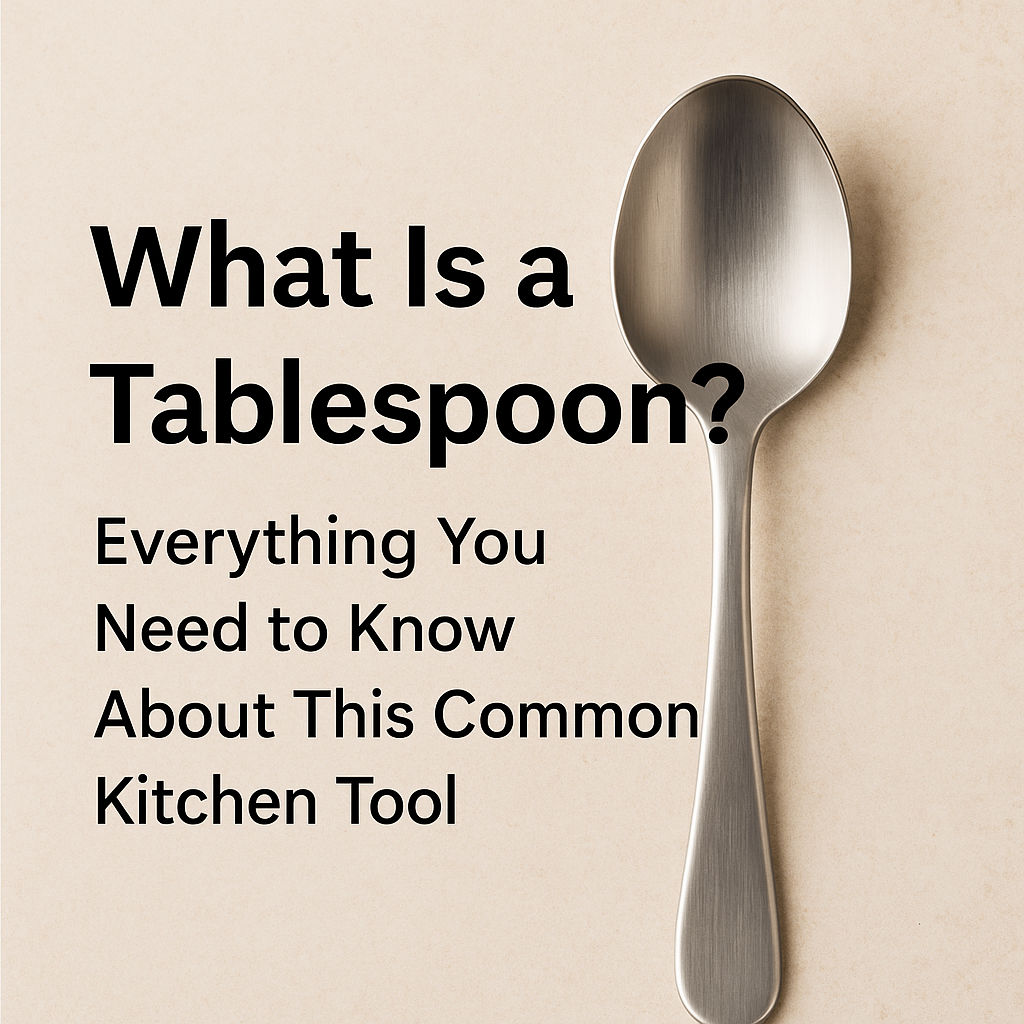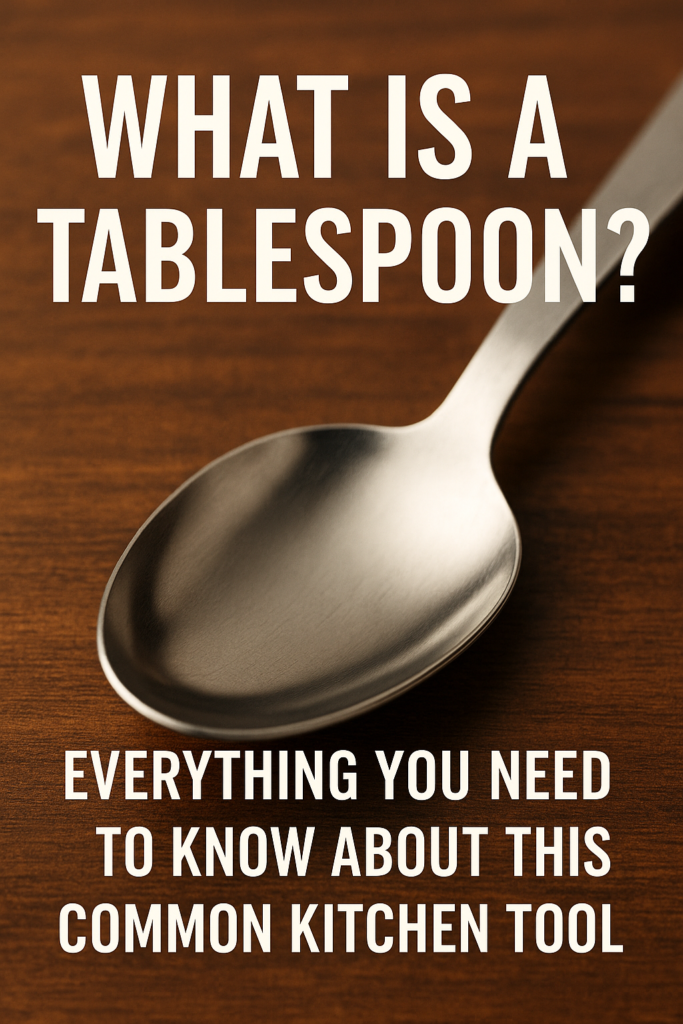
When it comes to cooking or baking, measurements matter – and one of the most used tools in your kitchen is the tablespoon. It may seem small or ordinary, but this simple utensil plays a big role in the success of any recipe. Whether you’re baking a cake, making salad dressing, or measuring coffee grounds, the spoon is everywhere, helping you keep things consistent and delicious.
In this detailed blog post, we’re going to detail everything you need to know about the tablespoon – what it actually is, how it differs in different fields, how to use it correctly, and even some smart tricks that go beyond measuring. So let’s get started.
- What exactly is a tablespoon?
A tablespoon, often abbreviated as “tbsp,” is a standard unit of measurement used primarily in cooking and baking. It is typically larger than a teaspoon and is used to measure both dry and liquid ingredients.
In countries that use the metric system, 1 tablespoon is equal to 15 milliliters (ml). In the United States, a tablespoon is generally considered to be about 14.79 milliliters, although most people round it up to 15 ml for practical use.
In addition to being a measurement unit, a tablespoon is also a piece of cutlery — larger than a teaspoon but smaller than a serving spoon — used to eat foods like soup or cereal.
- A Brief History of the Tablespoon
In the earlier days, tablespoons came in all sorts of shapes and sizes, and there was no real standard in terms of measurement. As recipes started appearing in cookbooks and consistency became important — especially in baking — people saw the need to standardize spoon sizes.
This led to the creation of measuring spoons, including a tablespoon, to ensure recipes could be repeated with the same results every time. Over time, kitchen standards became more unified, and the tablespoon we know today became a fixed part of cooking culture.
- Tablespoon vs. Teaspoon vs. Dessert Spoon
Let’s clear up one of the most common confusions in the kitchen:
1 tablespoon (tbsp) = 3 teaspoons (tsp)
The size of a dessert spoon is between a teaspoon and tablespoon, usually around 10 ml
Using the wrong spoon can ruin your recipe, especially in baking where accuracy is key. So, always use a proper measuring spoon instead of everyday cutlery when accuracy matters.
- Different Types of Tablespoons
Not all tablespoons are the same. Here’s a quick look at the types you’ll find:
By material:
Stainless steel – durable, easy to clean and the most reliable for precise measurements.
Plastic – lightweight and affordable, although they may not be as accurate.
Wood – great for stirring but not ideal for measuring.
Silicone – flexible, heat-resistant and scratch-free; great for working with nonstick cookware.
By design:
Engraved measurements – these have the measurements permanently etched into the handle.
Color-coded sets – useful for quickly grabbing the right size.
Adjustable spoons – these can be slid to measure different amounts, but may not always be accurate.
- Why using a tablespoon accurately really matters
Think about this: you are baking cookies and the recipe calls for 1 tablespoon of baking soda, but you accidentally use a heaping tablespoon or dinner spoon instead of a flat measuring spoon. Your cookies could turn out bitter or oddly fluffy. What a difference a small mistake can make.
Accurate measuring ensures:
Consistent flavor
Proper texture
Uniform cooking or baking
No ingredients wasted
In short, using a proper tablespoon keeps your recipe predictable and your food delicious.
- How to use a tablespoon correctly
Let’s understand this separately for both dry and liquid ingredients:
Measuring dry ingredients:
Use a dry measuring tablespoon.
Scoop the ingredient, then level it with a flat edge (like a knife or spatula) so it’s level with the top of the spoon.
Measuring liquids:
Use a spoon designed for liquids or carefully hold a dry tablespoon.
Pour the liquid into the spoon until it’s full but not overflowing.
Do this over a bowl to catch any spills.
✅ Pro tip: Avoid scooping directly from the bag or container, especially for powders like flour or cocoa. Use another spoon to fill your measuring tablespoon, then level it for accuracy.
- Useful Conversion Guide for the Kitchen
Here’s a quick chart that will help you convert between different measurements in your everyday cooking:
Measurements Tablespoon Equivalents
1/2 cup 8 tablespoons
1/4 cup 4 tablespoons
1 ounce 2 tablespoons (approx)
1 tablespoon 3 teaspoons
15 ml 1 tablespoon (metric)
Having these conversions handy makes it easier to follow both metric and US-based recipes.

- Common mistakes to avoid
Even experienced home cooks make mistakes with measurements. Here are some mistakes to be wary of:
Using a regular spoon instead of a measuring spoon
Don’t use the spoon you eat cereal with—it’s not designed for precise measurements.
- Smart Kitchen Tips with Tablespoons
Apart from measuring, your tablespoons have many other great uses in the kitchen:
Dividing cookie dough – You get evenly sized cookies with one tablespoon per scoop.
Filling muffin tins – Two tablespoons of batter per cup works great for mini muffins.
Scooping sticky ingredients – Things like peanut butter or honey come out cleaner if you lightly oil the spoon first.
Shaping pancake batter into rounds – A tablespoon helps control the size of mini pancakes.
Serving sauces – A tablespoon is a great serving size for gravy or dips.
- Tablespoon substitutions: What if you don’t have one?
Sometimes you need to improvise. If you don’t have a tablespoon:
Use 3 teaspoons (exact)
Estimate with a soup spoon, although not as precise
Use a digital kitchen scale – 1 tablespoon of water weighs about 15 grams
When in doubt, always aim to use actual measuring tools to keep your cooking consistent.
- Tablespoon in different cultures
It’s interesting to note that the size of a tablespoon can vary slightly depending on the region. For example:
United States – ~14.79 ml (rounded up to 15 ml)
Australia – 20 ml (bigger!)
United Kingdom – generally aligns with 15 ml
Canada and New Zealand – generally follow metric standards at 15 ml
So, if you’re following an international recipe, it’s worth double-checking which measurement system the recipe uses, especially in baking.
- Care and maintenance tips
If you want your measuring spoons to last a long time and stay accurate:
Wash after every use, especially with sticky substances.
Avoid scratching or bending metal spoons.
Store them together on a ring or hook to avoid losing individual pieces.
Don’t expose plastic or wooden spoons to high heat or harsh chemicals.
Final thoughts: A small spoon, a big impact
At first glance, a tablespoon might not seem like much—it’s just a spoon, right? But in the world of cooking, this tiny tool holds a big responsibility. It makes sure your cookies rise properly, your dressing has the right balance, and your soup has enough salt.
Learning how to use a tablespoon properly can really enhance your cooking skills. It’s one of those little things that makes a big difference.
So the next time you’re in the kitchen, stop and appreciate the power of the big spoon—because precision doesn’t have to be complicated. Sometimes, just a good spoon is all it takes.
